Finally I got to visit the White Tower which is one of the symbols of Thessaloniki. Originally, the tower was a part of the walls that surrounded the city, but over time it has remained to stand alone on the shore. During the Ottoman rule, it also served as a gaol and when the janissaries, elite army units, unsuccessfully rebelled against the sultan in 1826, they were first imprisoned here and then killed. For this reason, the building got the unofficial name of the Bloody Tower, but then marketing experts jumped in, the tower was whitewashed and renamed into the White Tower.
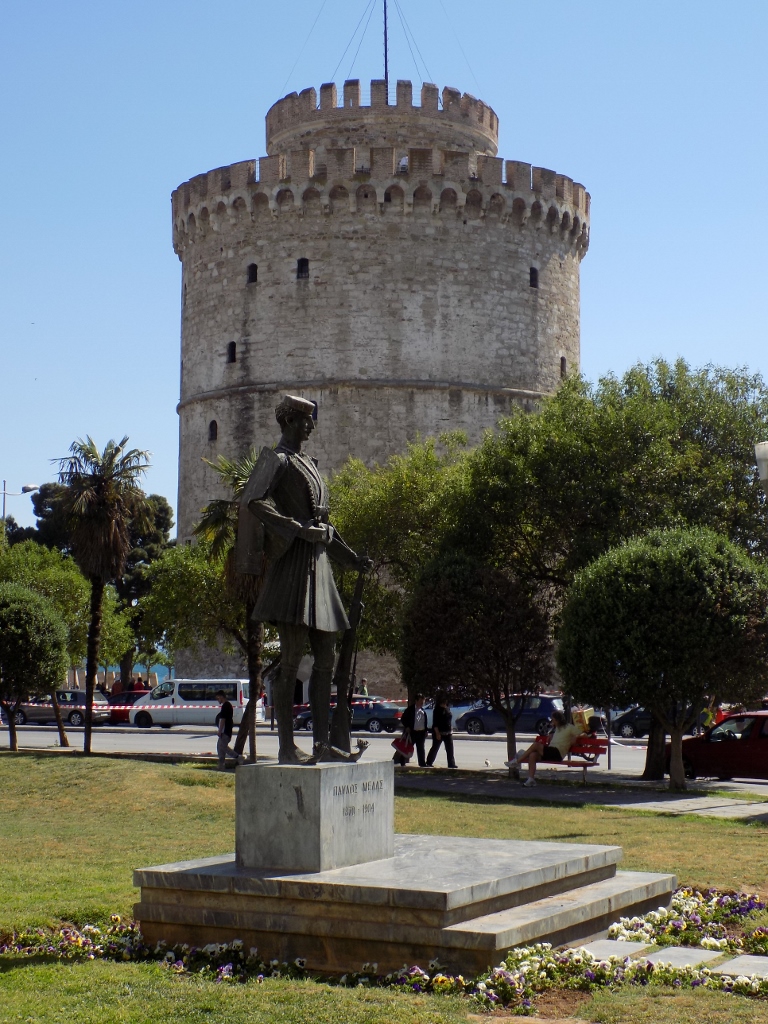 White Tower
White Tower
The White Tower is 35 metres high and when you enter it there is a broad winding stairway leading to the top. In the centre, at the level of “floors”, there are small exhibition areas, but it is necessary to go all the way up in order to have a stunning view of the city. Still, one may also bear in mind that the tower was built for the defence purposes and was later used as a gaol.
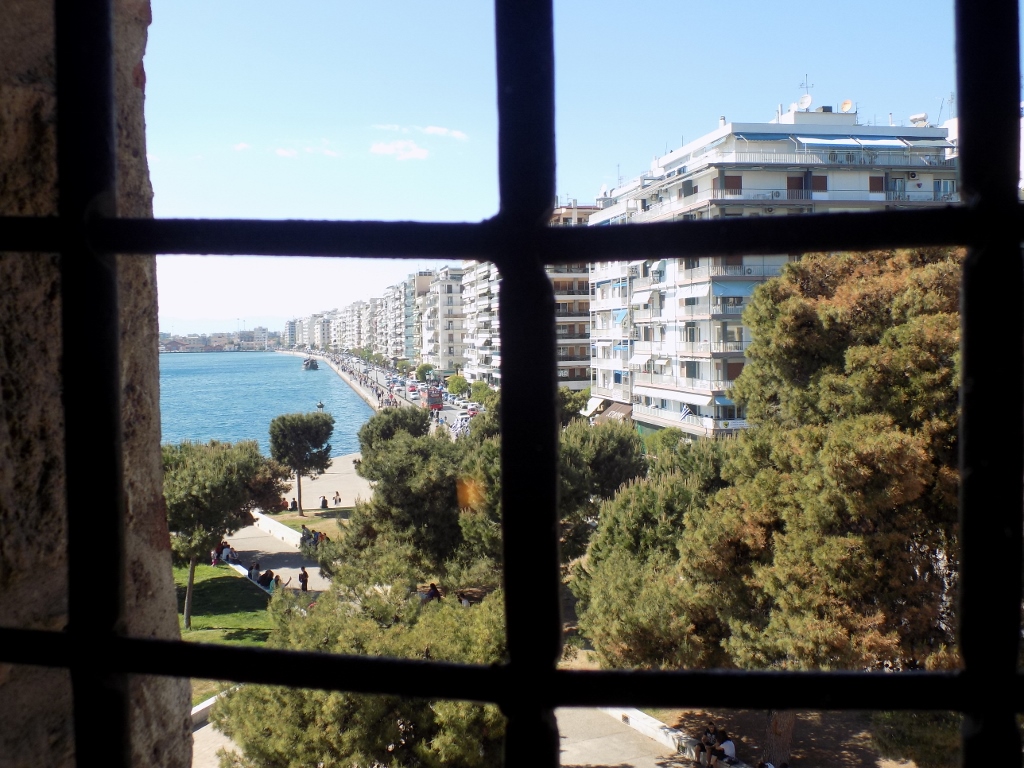 White Tower, view through a window towards Nikis Avenue
White Tower, view through a window towards Nikis Avenue
Then, walking slowly by the sea, I went to the Aristotle Square where I cooled down a bit with a tasty ice-cream. Afterwards I continued to a part of Thessaloniki that is particularly lively and full of cafes and restaurants. Although the entire city is filled with wonderful places to go out to and relax, this quarter seemed even more interesting. If you follow Mitropoleos street towards the west from the Aristotle Square, you will come across Katouni street and there, to the left and right, as well as in the part of the city behind this street, there is a myriad of places where one may sit, alone or with a company, have a good meal, drink and time. Highly recommended.
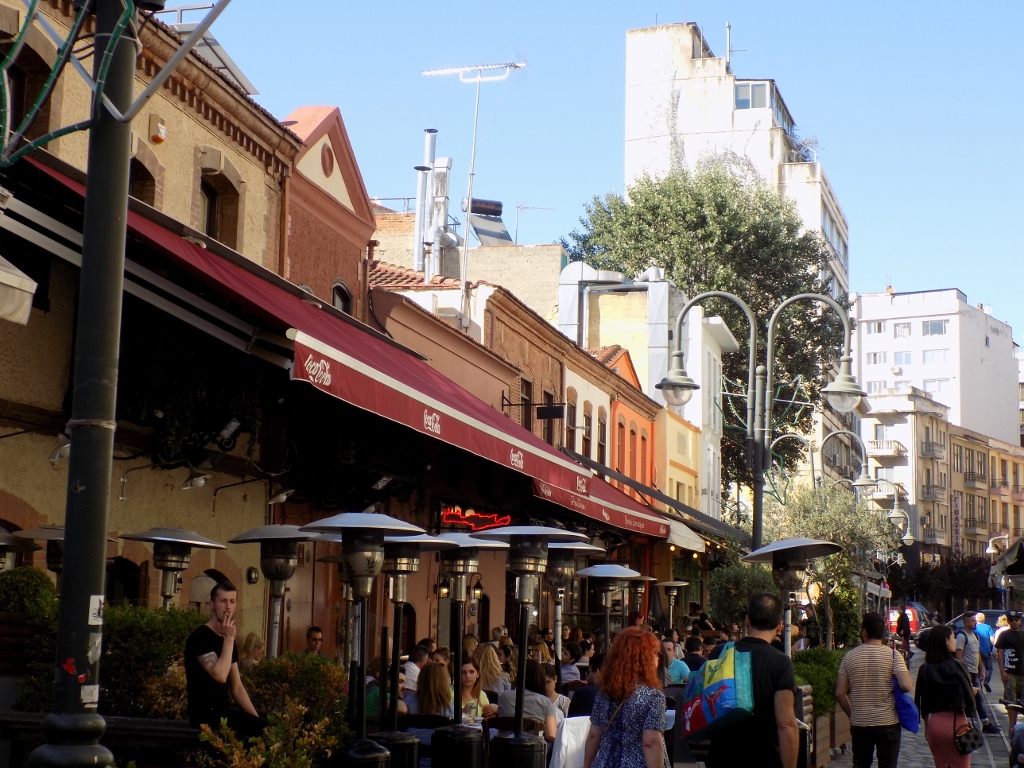 Katouni street
Katouni street
I was not hungry when I walked through this part of the city, but some time later, close to the flat in which I stayed, I passed by an unremarkable place that had a few tables out on the pavement that were all filled with local people. Admittedly, most of the restaurants and cafes in Thessaloniki are full, but I had a notion that this place may be especially good. I love to go to places where most of the guests are local people, but in Thessaloniki there are generally more locals than foreigners. On the other hand, I like even more to go to the places where in addition to young people there are also middle aged and elderly, but what I like most is to go to the places where several generations sit at the same table, eat and obviously have good time. Well, this was one such place. Each time I passed it, I saw a similar situation. Thus, one evening I decided to go there for my meal.
The menu in English was completely funny, improvised and almost unusable, but that did not discourage me. And it turned out I was right. The food was simple and yet fantastic. I took squid that was perfect, meaty, but easy to chew. I also got spinach and olives. And beer. Local. Always!
In the evening I went for a walk by the sea. This time I was going from the White Tower in the opposite direction from the centre and there is a very long quay. Later in the day and in the evening there are a lot of people walking there and it is quite a nice place if one wants to walk for several kilometres. But, I’m sure it is also quite nice to go jogging or riding a bicycle there in the morning.
As you move from the White Tower along the quay, there is a monument of Alexander the Great riding audaciously on his Bucephalus. Still, no matter how grand this monument is, I’m not sure if it is bigger than the one in Skopje. And now, it is the time for me to say a few words on the subject, as I personally see it, along with apologies for any emotional injuries I may cause inadvertently, because I love both nations and I think it is a GREAT pity and I’m truly sorry that they are at odds regarding the name of the state and everything else that goes with it.
Skopje is the capital of the, for the time being, officially “Former Yugoslav Republic of Macedonia” (hereinafter “FYROM”). The reason is that Greece has never given a permit for this indisputably sovereign country north of Greece to be simply called Macedonia which is the unofficial version most of the people and countries use. The north part of Greece covers a part of the historic territory that was called (and is still called) Macedonia. After all, Alexander was Great, but also of Macedon, for he was the ruler of Macedonia, as was his father before him. During the Roman domination, this province was also called Macedonia. And there is nothing debatable about this. Afterwards came Byzantium and the Turkish Empire. And since both of these states covered almost the complete territory of the Balkans, there were none of the problems that exist nowadays.
After the Balkan Wars and WWI, when the Kingdom of Serbs, Croats and Slovenes was founded, it didn’t occur to anybody to deal in particular with the Slav population that lived on the territory of the present-day FYROM, so this region was also called South Serbia with the Vardar Province there. And then comes the end of WWII when comrade Tito with his associates concocted a country consisting of six republics, one of them being Macedonia. This is when the national and political problems started to appear. Greece lays claim on Alexander the Great, which in my opinion is quite right, although historically the “ancient Greeks” (Athens, Sparta and the rest of them) were not thrilled with Philip or Alexander, who were the kings of Macedonia, and considered them to be barbarians, which is where one may even venture a comment. However, as far as Thessaloniki and its surroundings are concerned, the things are as clear as they can be – this is Macedonia without any doubt. All the royal centres of ancient Macedonia are situated on the territory of the present-day Greece, Thessaloniki was the centre of the Roman province of Macedonia, etc. Alexander the Great may not have been a pure-blooded Greek according to the taste of the Athenians, but he certainly belonged to ancient Greek culture.
On the other hand, a good portion of the present inhabitants of the FYROM belong to the Slav race and their language is Slavic by its origin and structure, but I think the problem keeps persisting based on the fact that a lot of those inhabitants were born in the “Republic of Macedonia” (the Yugoslav one from after WWII and the independent one) and they naturally identify with this term as the name of the country of origin, with a derived adjective “Macedonian” (as in “Macedonian nation”) and the name of the language – Macedonian. And now a new name that would be acceptable to both parties needs to be determined at some negotiations and these same inhabitants need to be told that from now on they are no longer “Macedonians” (in terms of the FYROM), but rather something else. Everybody would be messed up in their head. It is unclear what would have happened if Yugoslavia had survived, but with the gaining of independence the things only got more complicated.
To start with, the new state needed a name and Greece is adamant about not allowing the term Macedonia to be used. I guess this is precaution in case some territorial ambitions appear among the north neighbours. I personally really cannot imagine that any inhabitant of the FYROM with a clear head could ever claim that the entire north Greece belongs to them on account of the name, but I also think that the Greeks are right and wise and that certainly nothing should be left to chance. On the other hand, the FYROM has not been very wise and prudent when gaining independence, putting on one of the first bills they printed an image of Alexander the Great. As a kind of excuse, I have to add that in the former Yugoslavia the name of Alexander the Great went in parallel with Alexander of Macedon(ia) and the country had “Socialist Republic of Macedonia,” making it easy to create a linguistic link even without any historic grounds. If everything what the official history teaches us is true, the ancestors of the vast majority of the present-day inhabitants of the FYROM came to the territory of the northern part of Macedonia a thousand years after Alexander left it never to return again. Be as it may, it’s been years now (over 25 years!!!) that negotiations start, and then stop, and then the delegations part without finishing the job, and then they sit down again and start with discussions and negotiations, again with no agreement, etc. I don’t know which phase they are currently in, but in the meantime somebody in the FYROM came up with an idea to start building enormous monuments to Philip and Alexander the Great, naming motorways after them, etc. It will be difficult to find some good and mutually acceptable solutions in the near future with such an attitude.
But let me go back to much lighter topics, such as a relaxed tourist visit to Thessaloniki.
In addition to wonderful places to enjoy food and drinks, Thessaloniki is almost like Rome, every so often there is a structure from the past, from well preserved buildings, to parts of walls and remains of columns that may be seen in different places, and there is truly plenty of this. I often passed by a tiny little church which seems as if it has fallen from the sky in the middle of a residential area, but it is actually the other way around. New buildings have been raised around the church over time. And it is not the only one to be in this position.
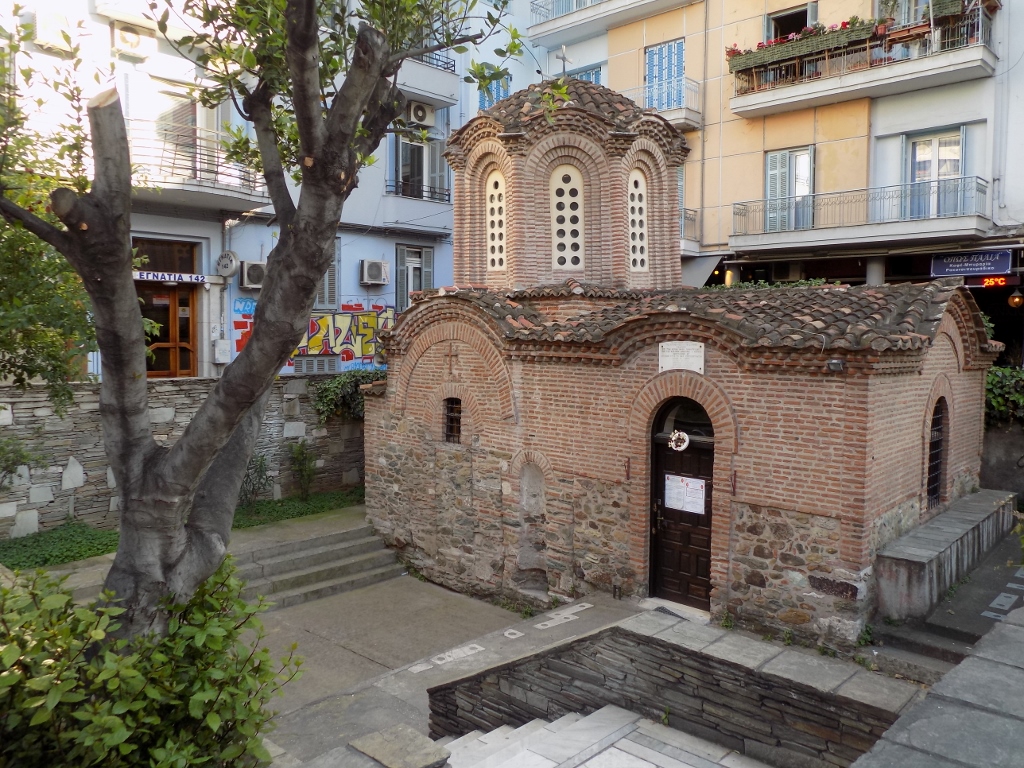 Church of the Saviour, 14th century
Church of the Saviour, 14th century
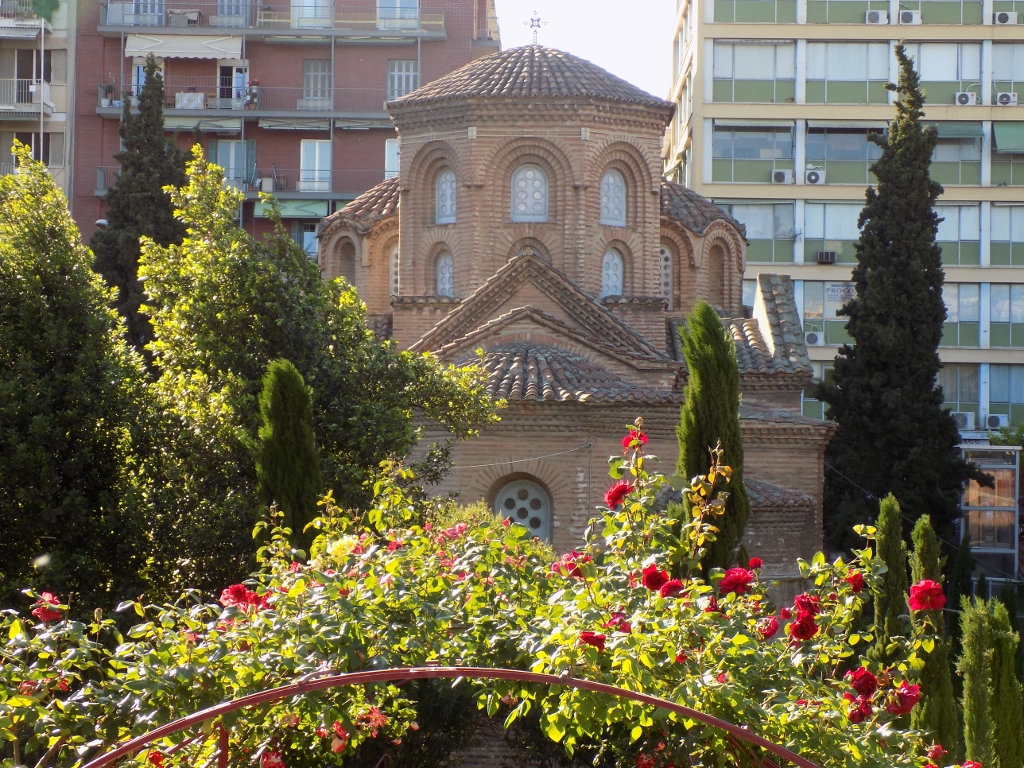 Church of Our Lady of the Coppersmiths (Panagia Halkeon)
Church of Our Lady of the Coppersmiths (Panagia Halkeon)
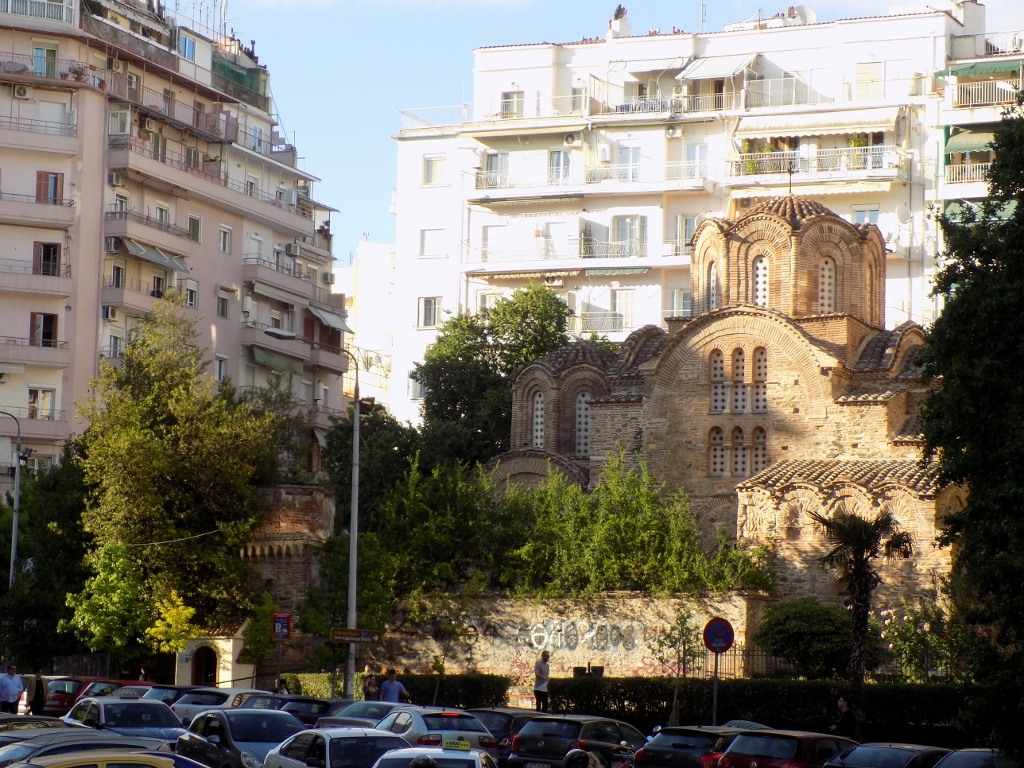 Church of Saint Panteleimon
Church of Saint Panteleimon
Very close to some of these churches, there are also remains from the ancient Roman times which so naturally blend in with buildings from the later periods.
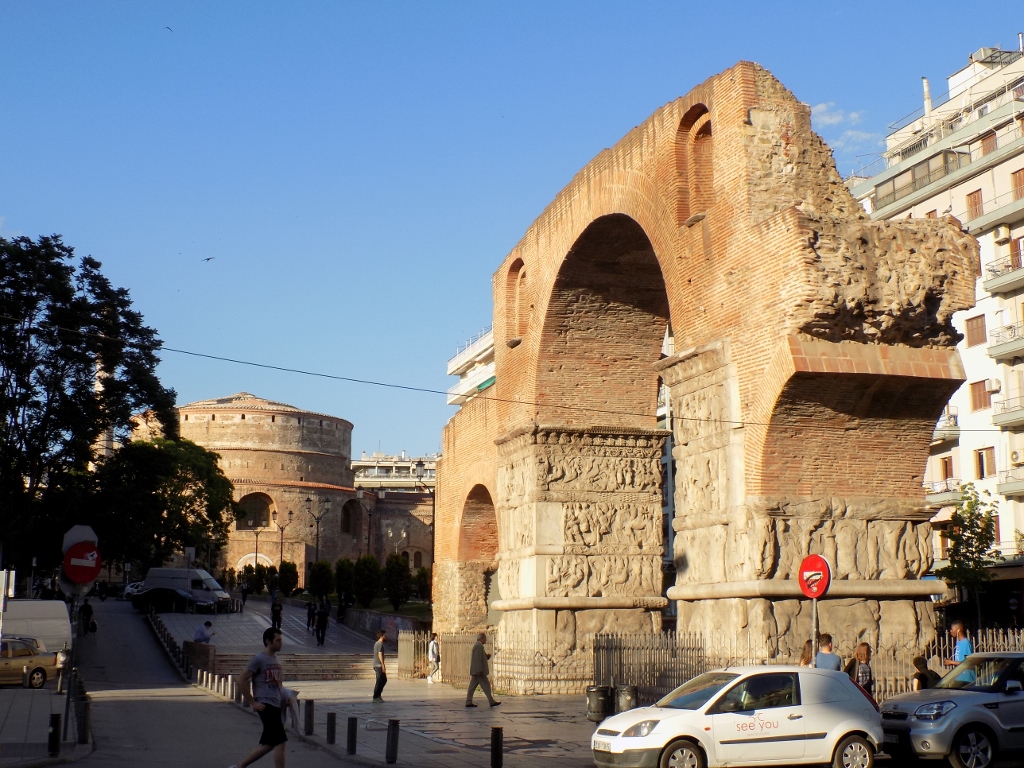 Arch of Galerius, with the Church of St. George or the Rotunda in the back
Arch of Galerius, with the Church of St. George or the Rotunda in the back
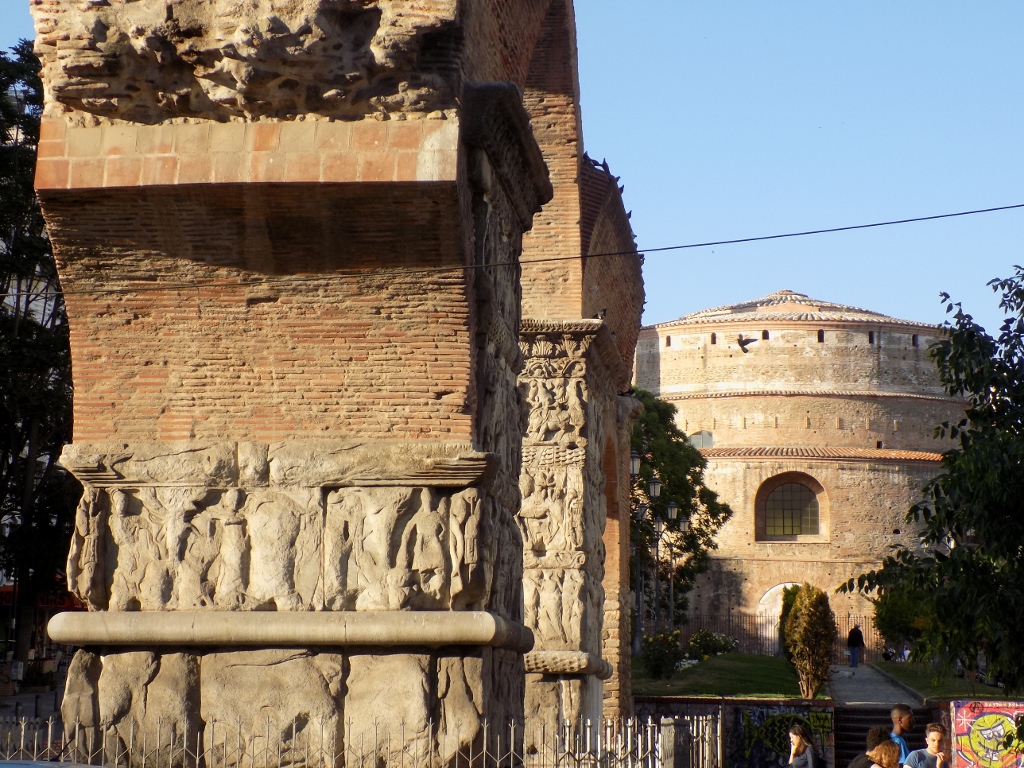 Arch of Galerius and the Rotunda
Arch of Galerius and the Rotunda
The Arch of Galerius is a monument built in the 4th century AD in honour of the Roman Emperor Galerius celebrating his victories in Persia, Mesopotamia and Armenia. On the other side of Egnatia street, towards the sea, there is a beautiful walking street that leads across the remains from the Roman times and in one section it expands into a broad plateau in the middle of which there are remains of the Palace of Galerius. It is possible to go down and visit it, walking along the paths that lead around the remains of the palace in order to learn more there, as there are boards nicely stating details about the leftover ruins seen there, but the site may also be viewed nicely by walking around the fence that surrounds it. If you try, you may also find a table in one of the numerous nearby cafes from where you will have a fantastic view at the remains of the 4th century palace.
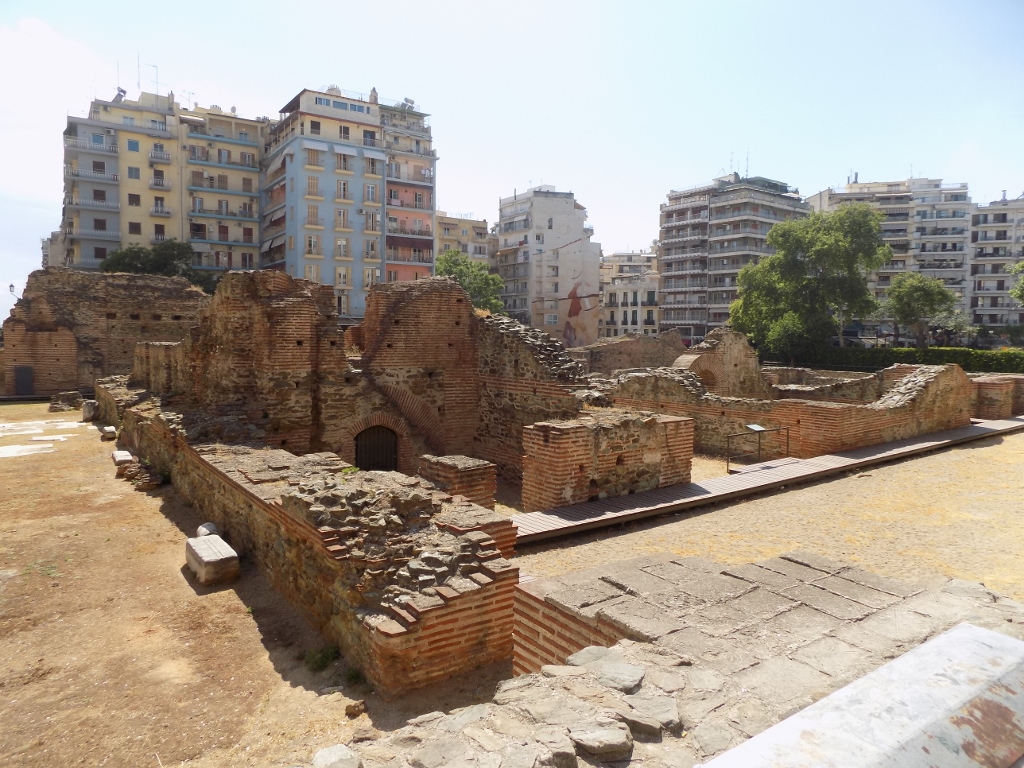 Remains of the Palace of Galerius
Remains of the Palace of Galerius
Still, the most beautiful remnant from the times of Emperor Galerius is the Rotunda built in the 4th century AD for the purpose of being a mausoleum for the emperor who was actually never buried there, as he died in Sofia (Bulgaria). (You can read about the final place of burial of this Roman Emperor in my story on: https://www.svudapodji.com/en/serbia-2006-2/). The building was later used as a church and during the Ottoman rule it also served as a mosque; there is a minaret still standing next to it. Nowadays, it is a monument of culture, but occasionally it is also used for religious purposes, since it belongs to the Greek Orthodox Church.
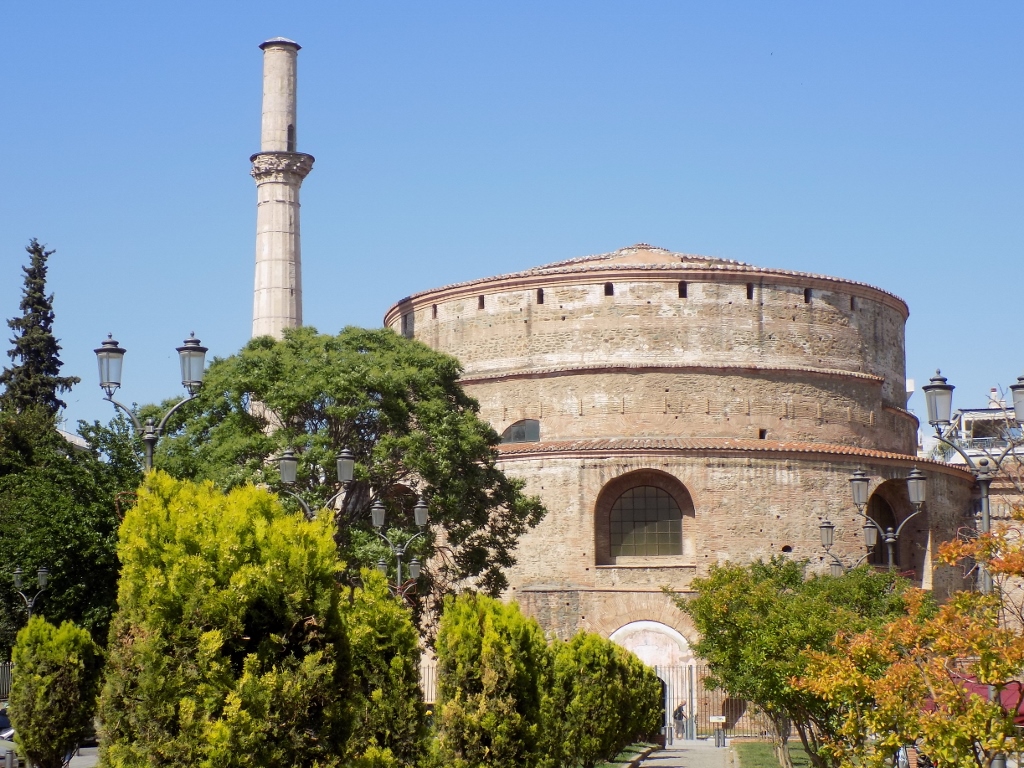 Rotunda
Rotunda
I went to visit it on a Sunday morning and it was great for there was nobody inside. Some of these places are truly great to visit when there is no one around. You can enjoy it without any disturbances. Admittedly, though, since I had had a chance to enjoy the Rotunda in peace and quiet, later, when a group came I was glad to hear the hushed murmur that echoed in this space.
The Rotunda, together with the Church of St. Demetrius and the Holy David’s Church houses mosaics that are master pieces of the early Christian art. Unfortunately, today one may see only the remains, but they are sufficiently large here making it possible to appreciate their excellence.
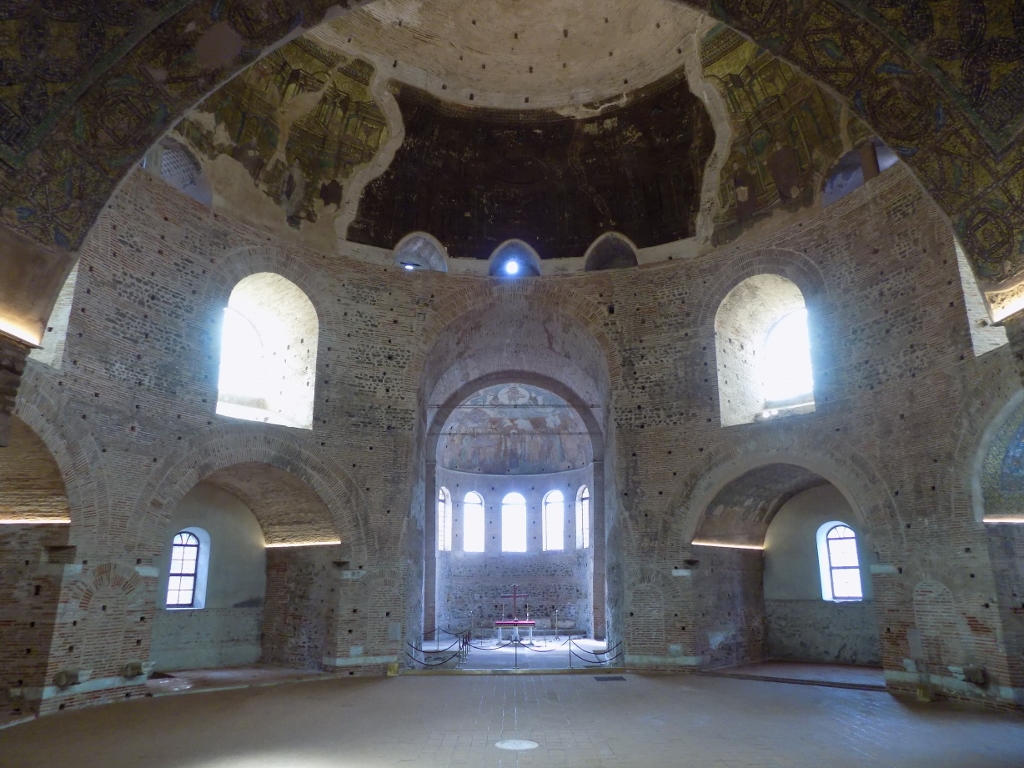 Rotunda, view of the sanctuary
Rotunda, view of the sanctuary
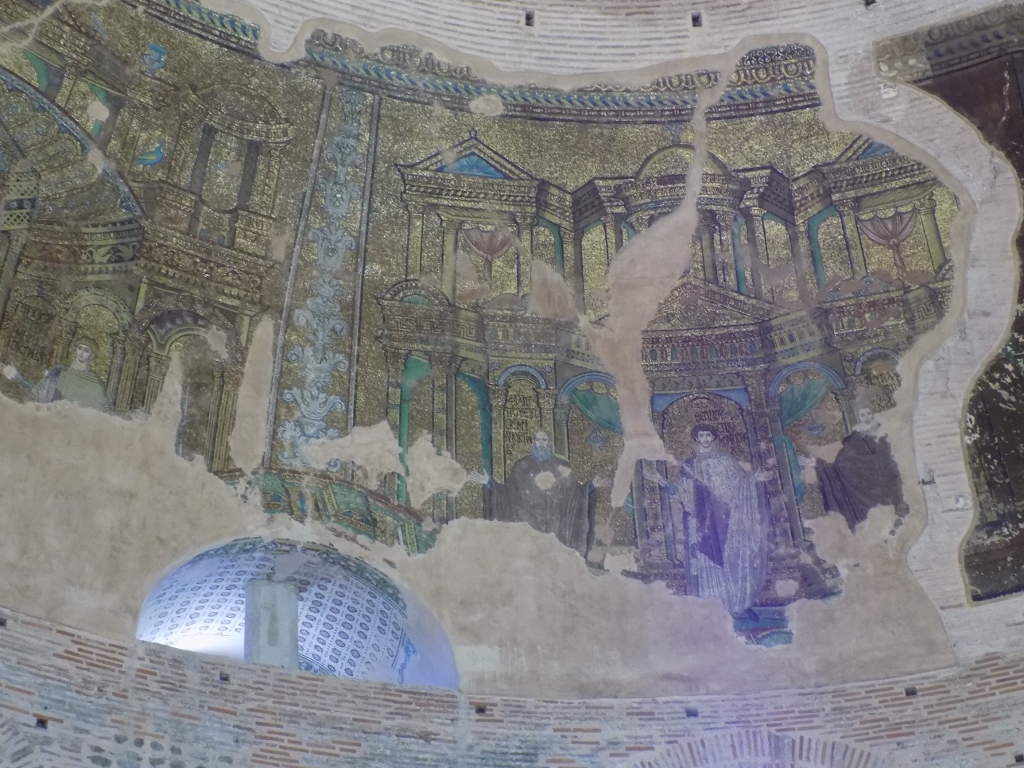 Rotunda, the mosaics
Rotunda, the mosaics
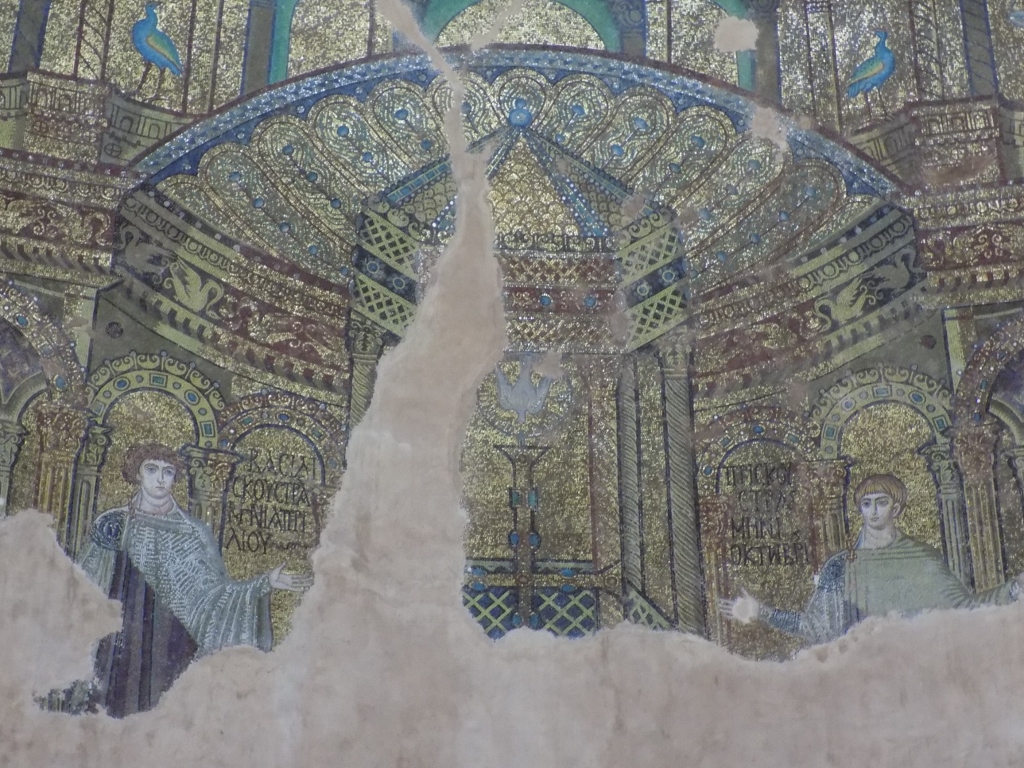 Rotunda, the mosaics
Rotunda, the mosaics
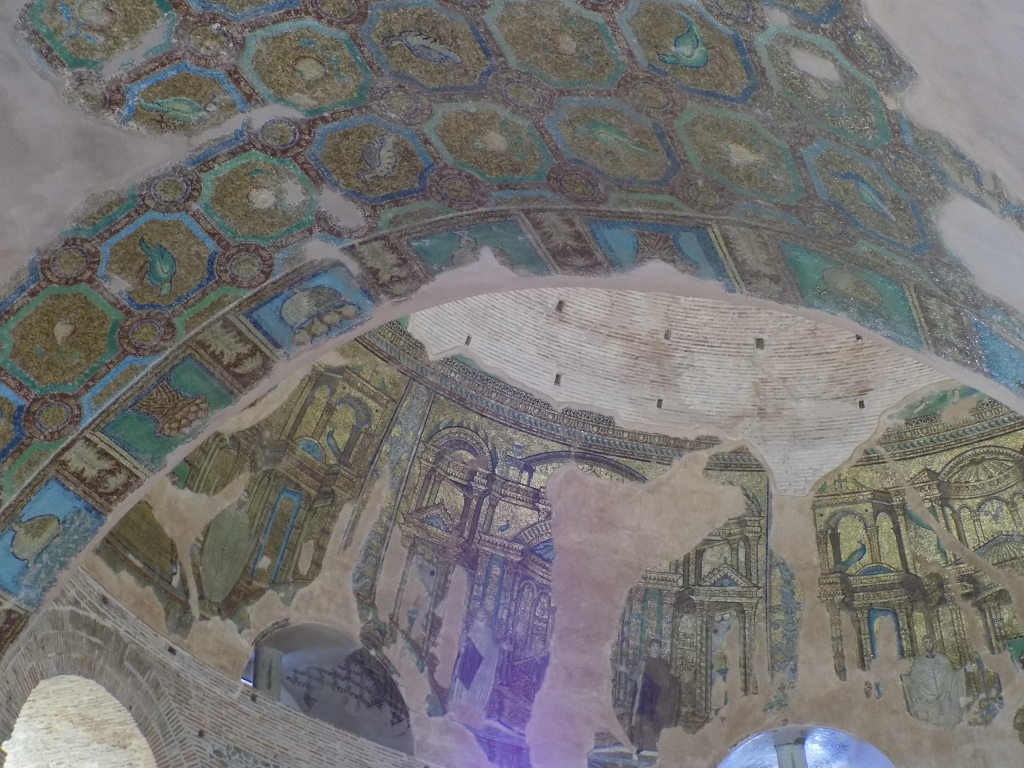 Rotunda, the mosaics
Rotunda, the mosaics
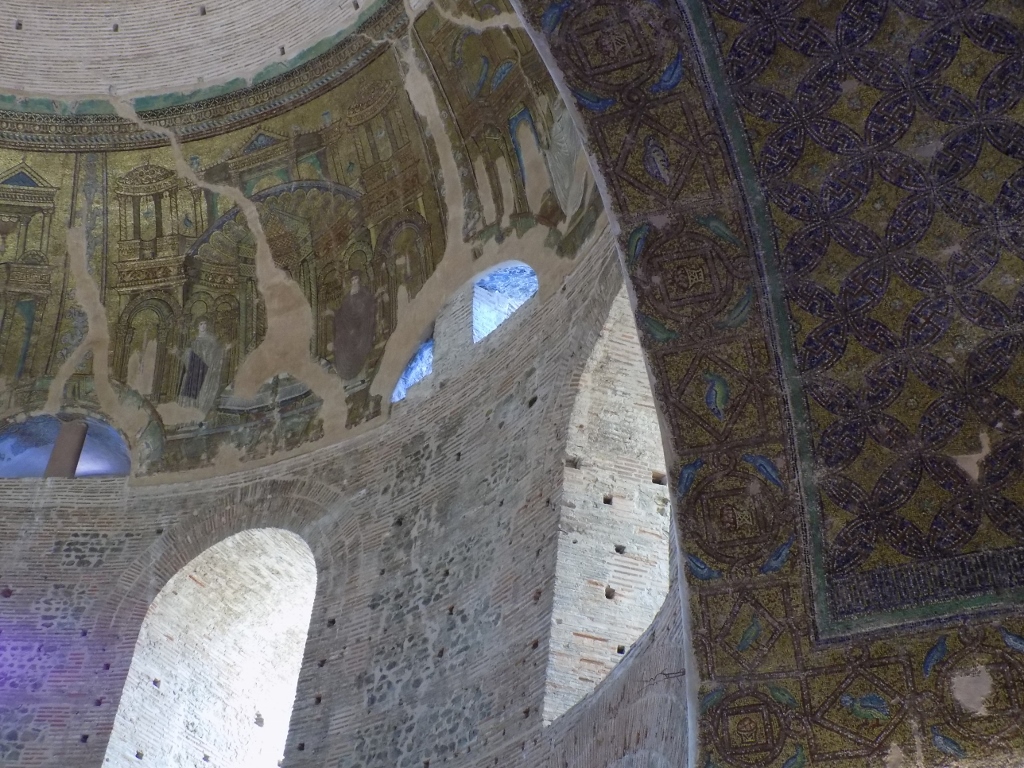 Rotunda, the mosaics
Rotunda, the mosaics
In addition to the remains linked to Galerius, there is a general property from the Roman times and that is the Roman Forum. By the way, the same thing was called agora in ancient Greece and this is in Greece, but it is from the Roman times, making it quite appropriately a forum. In any case, this is a square surrounded by public buildings and it used to be the centre of public life.
As a side note, the combined ticket I had bought a couple of days earlier was valid for three days and in theory it was also for the Roman Forum. Why do I say in theory? Well, because the site is open only until 2 or 3 pm and I came here a couple of hours later. It wasn’t a big problem for me though, since I had already seen it during some earlier visit to Thessaloniki. On the other hand, like in the case of the Palace of Galerius, the Roman Forum may also be seen quite nicely by making a circle around it. Moreover, as it is on a slope, it is possible to have nice views from different heights.
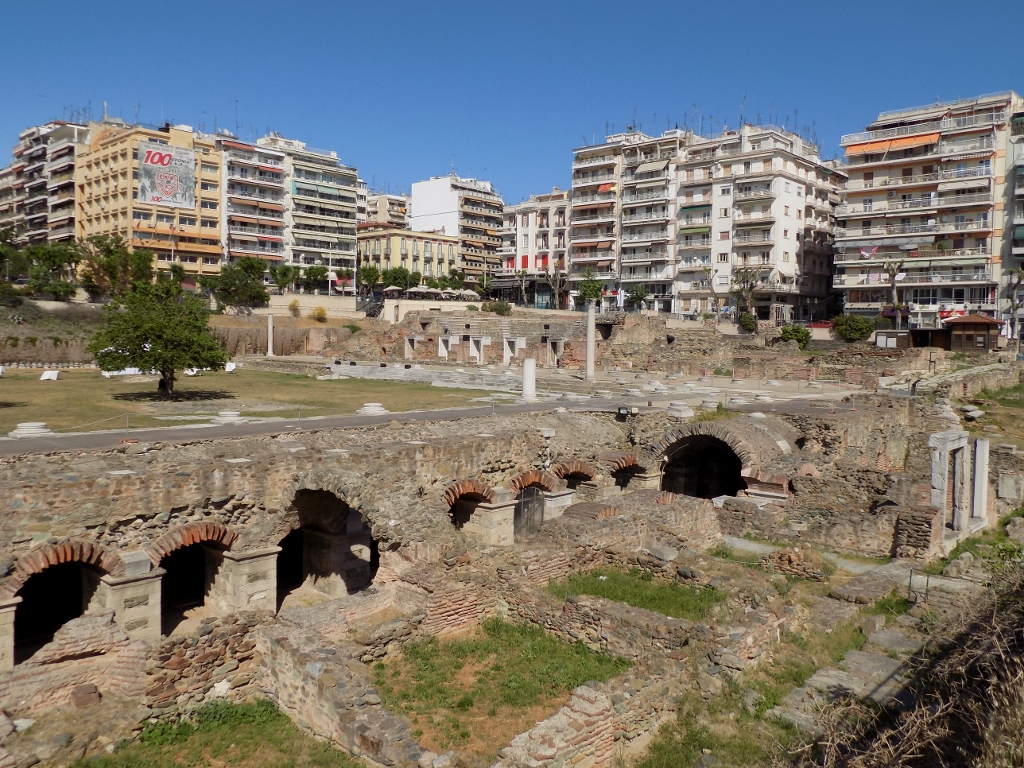 Roman Forum
Roman Forum
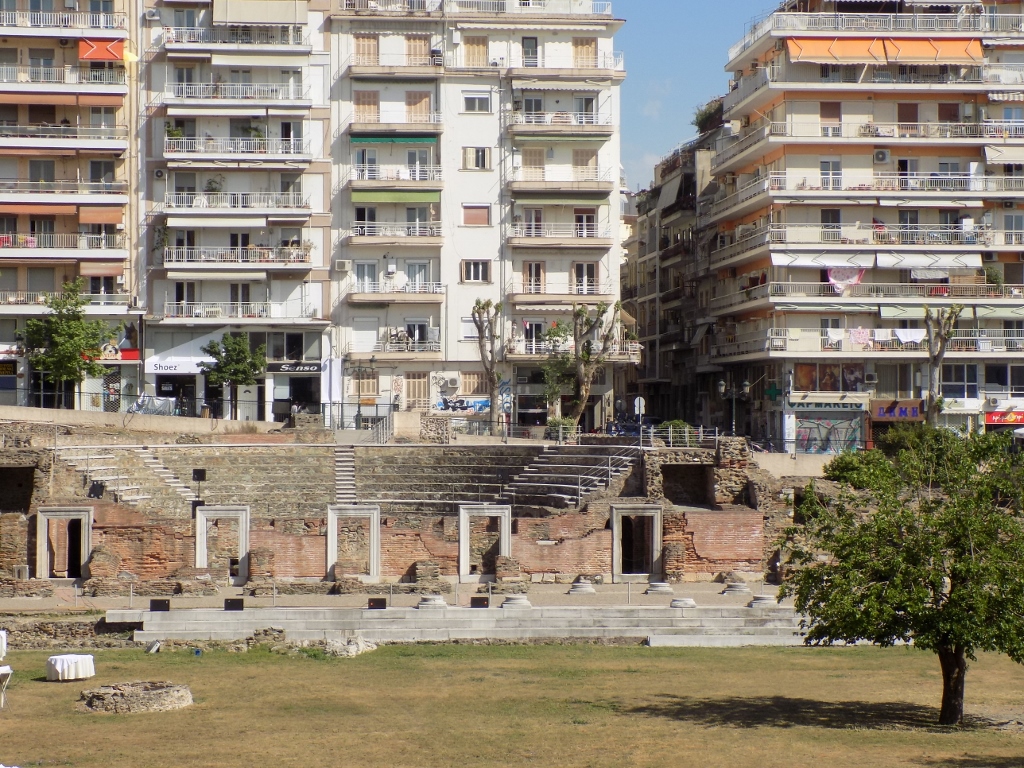 Roman Forum, the Odeon
Roman Forum, the Odeon
Still, I came to a conclusion that all the visits should be planned for the morning hours, as it was quite uncertain whether the sites one may be interested in would be open in the afternoon. For instance, the Church of St. Demetrius was opened during the entire day, but the crypt was accessible only from 8 am to 2 pm.